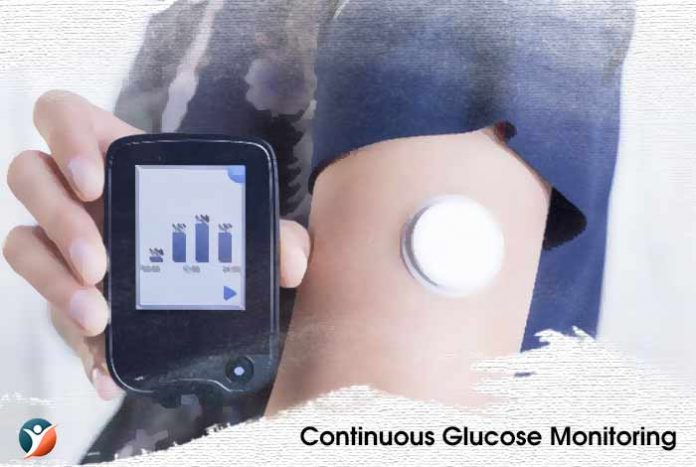
Table of Content
- What is Continuous Glucose Monitoring System?
- How CGM Functions?
- How CGM Is Necessary?
- Who All Can Use CGM?
- How CGMs are Different from Normal Glucose Meters?
- What Types of Continuous Glucose Monitors are Available in the Market?
- In the End
Usually done through a standard glucose meter or continuous glucose monitoring system, blood glucose level monitoring is a crucial aspect of both diabetes management and care. Not only does it help a diabetic keep track of his/her glucose levels at any given point of time, but also allows doctors to better plan out the treatment specific to any diabetes patient.
Continuous glucose monitoring system or just, continuous glucose monitor (CGM) is rather a new addition to the category of devices used to check glucose levels in patients with diabetes. It is particularly necessary when there is a need of keeping a constant check on frequently fluctuating glucose levels. As a matter of fact, CGM considered as an important diabetes management tool with improved outcomes in type 1 diabetes mellitus patients.[1] Keep reading to better understand this unique kind of glucose monitoring system.
What is Continuous Glucose Monitoring System?
The term ‘continuous glucose monitoring system’ is pretty self-explanatory and does exactly what it says. In contrast to the traditional glucose meter, CGM keep a continuous track of glucose levels all the time – throughout the day and night. The device is capable of taking readings at every 5-15 minutes.
By making use of the sensor, usually placed beneath the skin, it can record and show statistical trends and patterns with respect to blood sugar level fluctuations. These figures help a patient and most importantly, the doctor to have a clearer picture of your conditions and how well your treatment plan – including medications, diet and exercise – is helping you manage your condition.
The CGM devices are U.S. Food and Drug Administration (FDA) approved, and available for both adult and pediatric use, but only when prescribed by a registered medical practitioner.
How CGM Functions?
A CGM records the level of glucose in the fluid within and around the cells, known as interstitial fluid. Different CGMs works differently depending on the manufacturer and model. Broadly, CGM consists of three units, namely sensor, transmitter and receiver.
- Sensor: Connected with the transmitter and generally inserted beneath the skin, this unit is responsible for recording the amount of glucose in the interstitial fluid.
- Transmitter: This is placed over the skin, which wirelessly (most of the time) connects with the receiver.
- Receiver: This acts as a display unit of the size of a pager and displays all the relevant data and stats. A receiver is usually designed to be clipped on your belt or you can choose to keep it in your handbag.
The receiver can show you glucose levels at intervals of 1, 5, 5 and 15 minutes. It beeps an alarm in case there is an alarmingly low or high levels of glucose in your body.
Advanced CGM devices, currently available in the market, can be added to your home-based, personal diabetes care regimen. The data collected by the receiver unit can further be downloaded on your desktops, tablets and even smartphones to better analyze the sugar level trends and patterns. This allows your doctor to prepare the best as well as more accurate and customized diabetes management plan for you, which may include:
- Daily insulin dose(s)
- Best suited exercise plan
- Required number of meals and snacks and total calorie intake in a day
- Proper medication types and doses
Most of the CGM systems needs the sensor to be replaced beneath the skin after every 3-7 days. If a diabetes patient is using an insulin pump, he/she can also connect and synchronize the same with a CGM system for continual diabetes care. This voids the need of programming the pump manually as in case of methods requiring finger pricking. The U.S. FDA has also approved several devices for the same.[1]
In this regard, even the scientists hope that in association with insulin pumps, the utilization and clinical utility of CGM would enhance.[1]
How CGM Is Necessary?
Continuous blood glucose monitoring system is basically required when there is a need to keep track of blood sugar constantly throughout the day and night for a period as along as a whole week. Continuous glucose monitoring system helps in the following ways:
-
- Records alarmingly low blood glucose levels, which usually go unnoticed.
- Tracks abnormal surge in blood sugar levels between meals.
- Detects early morning increase in blood sugar levels.
- Aid in analyzing the effect of daily exercise and diabetes diet plan on your body.
- Tells if you are going well with your diabetes treatment plan on a daily basis.
Who All Can Use CGM?
It is to be noted that not every person with diabetes requires CGM. Only a few diabetics require using a CGM, and whether they need or not can only be decided by a doctor. Usually, a patient on intensive insulin therapy is suggested to go for continuous glucose monitor. A diabetologist may suggest CGM if the patient is:
- experiencing major lows and highs in his/her blood sugar levels for unknown reasons.
- using an insulin pump
- having blood sugar levels that are either extremely high (hyperglycemia) or too low (hypoglycemia)
- is suffering from gestational diabetes
As far as recommended age for the use of CGM is concerned, adults as well as children aged 2 years and above can go for this device. Interestingly, the U.S. FDA has also approved several smartphone apps to be paired with CGMs for better tracking and ease of use. [1] This further helps caregivers and parents of children with diabetes, who can’t stay close to the patient all the time.

How CGMS are Different from Normal Glucose Meters?
Despite the fact that the purpose of both CGM and glucose meters is quite similar, they both are different in several ways. Let’s see how:
-
- Unlike blood glucose monitor, CGM does not require extracting blood through pricking.
- BGM can only give the approximate concentration of glucose in the blood at a specific point of time, whereas CGM continuously tracks your sugar levels for days and automatically take readings after every 5-15 minutes.
- CGM is relative way more expensive.
- CGM is not necessarily recommended to every diabetic.
- BGM doesn’t require a sensor to be placed under the skin, which is the case with CGMs.
- Using a glucometer is very simple to use. However, you might need some training to get used to with a CGM. A little practice may also be required to better understand its functions and how to operate it.
- CGM measures glucose level in the interstitial fluid, whereas glucose meter records glucose level in the blood.

What Types of Continuous Glucose Monitors are Available in the Market
The demand and need of continuous glucose monitoring systems have increased manifold in the last couple of years and hence, a variety of CGMs have been introduced in the market with diverse functionalities and features. Discussed below are some of the popular continuous glucose monitors:
- Abbott Laboratories:
FreeStyle Libre: It is basically a flash glucose monitoring system. The FDA-approved Freestyle Libre stands somewhere between a CGM and blood glucose meter.
Freestyle Navigator: This comes with a tiny on-body sensor, transmitter and off-body receiver.
Freestyle Navigator II: The receiver comes with color display and the transmitter is of the size of 3 cm by 3cm with 1 cm depth.
- Dexcom:
Dexcom G4 Platinum CGM: This CGM sports a latest, slim, black design that goes well with your smartphone or MP3 player.
Dexcom Seven Plus CGM: It makes use of GPS technology and available with Dexcom’s Data Manager software.
- Medtronic:
Medtronic Enlite Sensor: This allows persistent glucose monitoring with Medtronic CGM and insulin pump.
Medtronic Guardian REAL-Time: This standalone device is exclusively designed for diabetics requiring multiple insulin doses in a day.
In the End
No wonder, continuous glucose monitoring (CGM) systems or just, continuous glucose monitors (CGMs) have evolved as a wonderful and effective way for diabetes management, especially for those, who are on intensive insulin therapy.
Not only does it help a doctor in deciding the best diabetes management plan for the patient with respect to diet, exercise and diabetes medications, but also helps the latter to personally take better care of him/herself.
Scientists and medical technologists are continually making efforts to develop more advanced and user-friendly continuous glucose monitors. Interestingly, it is an integral part of research focusing on the development of artificial pancreas that can mimic the role of natural pancreas in controlling insulin level in the body.
As of now, provided the ever increasing global prevalence of diabetes, CGMs can surely be regarded as boon to patients with type 1 diabetes or a severe case of type 2 diabetes.




